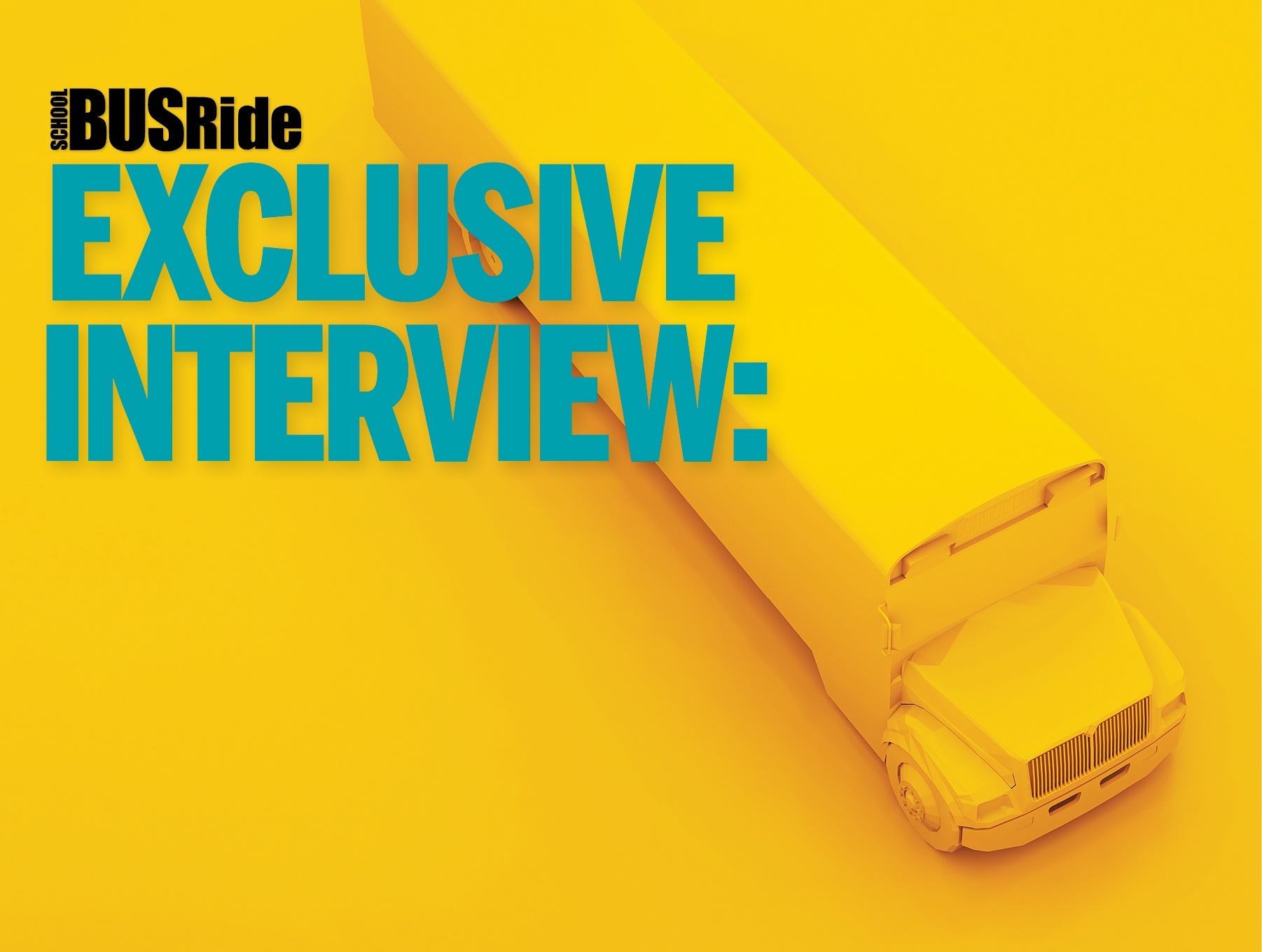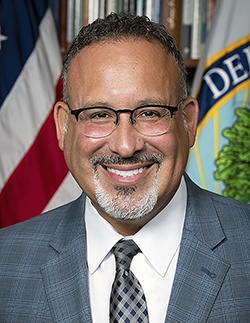
National Association for Pupil Transportation (NAPT) Executive Director Mike Martin met with U.S. Secretary of Education Dr. Miguel Cardona for this exclusive conversation in School BUSRide. Cardona clearly understands the valuable contribution of yellow school bus transportation to the nation, saluted school bus drivers, and offered his thoughts on the issues facing our industry in the new year,

Good afternoon, Mr. Secretary. Thank you and your staff for the opportunity to speak with you about pupil transportation. This is an incredible honor for me, the National Association for Pupil Transportation, and the thousands of professionals who operate yellow school buses in the U.S.
Let’s do this more regularly. Our drivers are unsung heroes in so many ways, and I can tell you from experience that if it weren’t for the drivers, kids wouldn’t have eaten. So I’m honored to be here and hopefully we’ll do more of these.

Thank you again. That would be my pleasure. These are critical times for education, and we applaud you, especially for your leadership in prioritizing the reopening of schools and keeping them open. Thank you also for acknowledging the importance of pupil transportation—and the role of school bus drivers—as a critical component of learning, and broader community support. What a gratifying message to send to school districts across the country as together we do our best to keep school buses running.
Could you share with us your perspective on what our organization and members nationwide can do to help you keep this momentum sustained?
Well, I appreciate that. And I appreciate the tone of that question, to be honest with you. I think one thing we learned during the pandemic is that we’re in this together, right? We were in it together, in the thick of it, and we had to take care of one another. Our actions impacted our community. And as we come out of that, let’s keep that guiding us, that we are all part of the solution. So what I would say is, number one, let’s acknowledge the work of our drivers to keep our students fed, to keep our students learning, because in many cases they were delivering devices. They were ensuring that our students had access to those tools that they needed. They connected with their peers, with their teachers. And in some cases, our students use their devices to have telehealth access.
So our bus drivers really, I mean, as a former school principal and teacher, I know how important they are in the success of our school communities, but they’ve really demonstrated to our country the important role that they have. So first of all, acknowledging them, and also recognizing that as our students’ needs shift, we have to continue to be malleable to address who it is that we serve, which is our students. So just like we know educators change how they did business from one day to the next, so did bus drivers, and we have to be prepared in the future to do whatever we need to do to meet the needs of our learners. We have to continue to communicate together proactively with that central mission of guiding every decision we make. And you’ve proven that in the last year and a half, and I know it will continue moving forward.
Education is not the only market space facing daunting human resource challenges from the COVID pandemic. The wholesale and retail sectors also are experiencing a shortage of commercial drivers, even though many of them pay more than school districts and other service providers.
As an experienced educator, and now Secretary of Education, what are your thoughts about what school transportation service providers should do to differentiate from other transportation providers in the reality of this current labor market?
Yeah, you’re absolutely right that the labor market, showing that there are needs and jobs unfilled in many places, which is causing disruption in so many other areas, education is not immune to that. I know, as a father that my children, they play extracurricular sports after school. And we would get, as parents, we would get notification of changes in schedule because of the availability of drivers or lack of availability is a better term. And again, we’re not immune to it.
So what can we do? You know, salary is one thing, we need to make sure that our drivers have a livable wage, but we also have to make sure that they’re feeling that they’re part of something bigger, right? That they’re part of the mission of helping children grow. And they need support in many ways that we all need support. They need to feel supported in their job value, listened to, I think job satisfaction often comes not from just salary, but from being a part of a tight knit community where your voice matters. So I think it’s really important that we can take some notes from our bus drivers on what they’ve seen and how we can continue to improve operations based on their experiences.
I know our industry will appreciate hearing that message. And it will be tremendously influential. I believe our members would also benefit from a better understanding about the extent to which some of the ARP and ESSER funding sources can be used for transportation purposes. Is there anything specific you would recommend that a local transportation director should do as a follow up to our conversation today?
That’s a great question. You know, when the American Rescue Plan funds were passed by Congress, President Biden’s intention here was to provide resources, to make sure that our schools can safely reopen. I don’t have to tell you the impact that remote learning has had, and the importance of in person learning opportunities that are safe for our students. I don’t have to tell you that. The president understood that. The funds are there for that. So that means that getting children to school safely is part of that. So funds should be used, not only can they be used, they should be used to make sure that we have ample staff that drive our buses and to have students coming into school. What good is it having a school safe environment if we can’t bring the children there? So I’m concerned when I hear that schools are closing because there’s inadequate staffing when there’s millions of dollars available.
Now I recognize it’s not that easy. Having been a former school principal and having to get called in the morning that I don’t have adequate staff, there’s a lot of scrambling going on. But there are resources now that should be used to provide incentives, bonuses, hiring bonuses, that’s all possible. And that’s all why the American Rescue Plan was passed. We did provide an FAQ in November with detailed information, and I think people need to feel comfortable saying if the funds are being used to keep our students in the classroom, that’s what you should be using them for. So let’s get creative, let’s work together. Let’s learn from one another. The American Rescue Plan funds are there as much to make sure that the kids are getting into school as they are for PPE and other devices that we know are aimed at keeping children safe.
Our members are responsible for providing school transportation for children across the nation, including those with special needs. And we know that’s been an incredible challenge for school administrators, but even more so for parents and students themselves. We appreciate the Department of Education’s clarifying guidance to assist people in the field. Do you have any other information our members should seek within the Department, or staff they should be talking to about challenges for the individuals they’re trying to serve, and especially students with disabilities?
Yeah. You know, our students with disabilities were impacted. I would argue more so than most students. Many of them rely on those assisted devices and the small group construction. And in many cases, one for one support that they didn’t have access to during the height of the pandemic. Therefore, it’s critically important that our students with disabilities have in person access and that may pose additional challenges. But with additional funding and creativity and flexibility, we should be able to do that. We’ve had dozens and dozens of listening sessions, including from our parents who, I had the parents who have really done amazing work, not only being patient, but also trying to make up for the time that the children weren’t in the classroom. And it has to sacrifice a lot. It’s critically important that we get our students with disabilities into the classroom. And again, use additional funds from the American Rescue Plan.
Even if that means, due to social distancing or meeting additional staff, that we use the funds for additional runs, for additional staff, to supervise and provide a safe ride to school. I know often there can be challenges, but at this point we want to get our students back as safely as possible. And during this period where we’re still not out of the woods with the pandemic, it’s critically important that we do what we need to do to get the kids back in school. Our staff is available to provide more technical assistance, specific technical assistance, happy to do so, it’s our responsibility to serve and to provide options. And in many cases to provide support for those districts that are wondering if the decisions that they’re making are okay. We want to encourage folks use the money to get kids in school. That’s the goal.
Thank you. Your Office of Special Education Programs is terrifically helpful in that regard. Final question for you: Any other thoughts you would like to share with us and the viewers about the Biden administration’s initiatives, and goals for public education?
Look, we’re on the doorstep of transformative change in education. I’ve been in education over 20 years, and I know many of the drivers across the country, that’ve been in education for decades as well. I have drivers in my family. And I know that the best days of education are still ahead of us. We have the potential for universal kindergarten for three or four year olds, which is critical to the foundation of their learning. We have access to Pell grants that are greater, which means that Americans of all ages can go back to school.
So many of your drivers might say, I want to go back now because I have a health eligibility. And we know we’re providing funds and support to those institutions that, whose purpose, is to support those who have been underserved in the past. I’m really confident that with that and the workforce fund that we’re going to help our students get internships and do apprenticeships. We’re really not only going to turn around education and really move it in the direction we want it to move, but it’s going to lift our economy. I’m excited about it. But before I close, I want to, again, thank the drivers who have bent over backwards, have been flexible. And in many cases were the front liners, when most of us were working from home, they were on the road. And I want to say thank you. And I appreciate you. I see you and our students are better because of you. Thank you.
Again, thank you, Mr. Secretary, for your leadership, and for making it a priority in your very busy schedule to share your thoughts with the school bus industry. We look forward to continuing to engage with you and your team.


